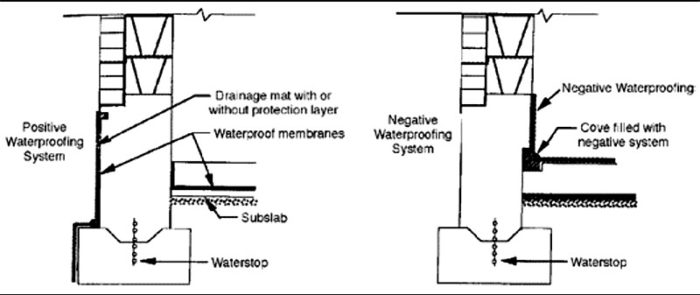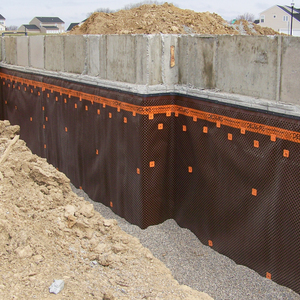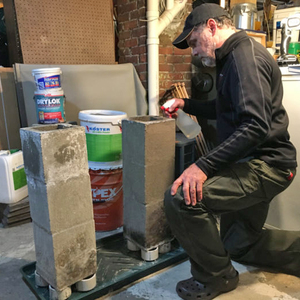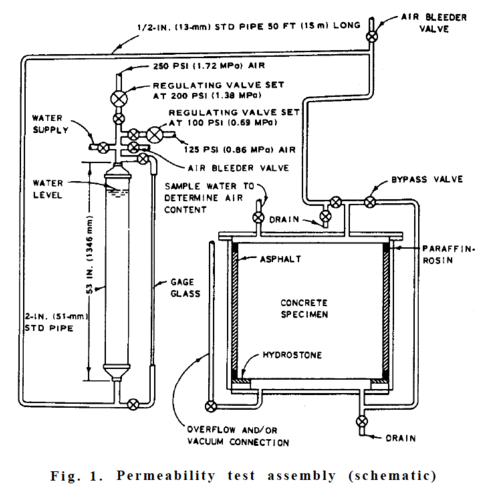
Image Credit: Image #1: Tim Garrison, The Builder’s Engineer — www.abuildersengineer.com
Image Credit: Image #1: Tim Garrison, The Builder’s Engineer — www.abuildersengineer.com Electron microscope image of Xypex crystals.
Image Credit: Image #2: Xypex This waterproofing selection chart provides a useful approach to separating the wheat from the chaff when choosing a waterproofing product. (Click on the image to enlarge it.)
Image Credit: Image #3: NAVFAC This image from a Tremco Technical Bulletin shows how challenging it can be for negative-side waterproofing to prevent below-grade water leaks.
Image Credit: Image #4: Tremco The Koster NB1 system includes a cove detail at the cold joint formed between the foundation wall and slab.
Image Credit: Images #5, #7, and #8: Koster American Corporation This illustration is one in a series depicting the steps to the Hammer & Hand approach to interior basement waterproofing. (Hammer & Hand is a builder with headquarters in Portland, Oregon.)
Image Credit: Image #6: Hammer and Hand In this 36-wythe foundation wall there is an interstitial space into which the Koster injection system was installed. Note the taps and installler in this image of the Koster injection system being used on a concrete block wall in the Empire State Building.
Negative-side waterproofing (NSW) is a tough topic that I have frankly been dancing around for quite some time. Manufacturer claims and homeowner anecdotes of successful interior waterproof solutions for basement walls and slabs did not completely add up. But I did not think that I understood the topic or the physics well enough to challenge the claims or explain my skepticism.
But I finally got the adult supervision that I needed, mostly from The Manual of Below-Grade Waterproofing (2nd edition, 2016) by Justin Henshell.
Key takeaways from the Henshell manual
- Reduce first. Always start by assessing and identifying surface water problems and by implementing management approaches that ease or eliminate the load you are trying to address from the interior of existing below-grade structures.
- “Membrane waterproofing is unsuitable for negative-side waterproofing [emphasis added] because the external water pressure can easily disbond the membrane from the wall.”
- There are three generic types of negative-side waterproofing but the most common today are the crystalline coating materials such as Koster NB1, Tremco PQ200, and Xypex. (See Image #2, below.)
- The standardized test used for NSW is the U.S. Army Corps of Engineers CRD C48-73, Permeability of Concrete. Six-inch diameter, six-inch long cylinders are coated to ½-inch thickness and subjected to a hydrostatic pressure of 200 psi (about 460 feet of head).
- Crystalline coatings penetrate the concrete and build crystal lattices within the concrete such that they can resist water pressure from the opposite side.
- “Crystalline coatings can close hairline cracks – i.e. cracks up to .012 inches wide. Moisture reactivation of the sealing process gives the coatings the ability to self-seal, according to manufacturers. But no negative-side waterproofing system can bridge dynamic cracks and reseal ruptures [emphasis added].”
- “Although it is effective as a waterproofing coating, the higher vapor permeability of negative-side waterproofing is a drawback in underground structures with occupancies and materials sensitive to high humidity [emphasis added].”
- Henshell cites and reprints a useful waterproofing selection procedure from U.S. Navy publication NAVFAC DM-14 (see Image #3).
Key takeaways from other sources
A best-practice primary waterproofing solution NOT relying on NSW
Hammer and Hand (a builder with headquarters in Portland, Oregon) generously offers and thoroughly details their existing basement approach here. (See also Image #6.)
“Curtain wall” injection
There is an approach you can take for primary waterproofing from the interior of existing basements or other below-grade structures: chemical injection or “curtain wall” injection.
Injection holes or ports are drilled into an interstitial space or right through to the exterior of foundation concrete, typically spaced 18 to 24 inches on center. A slurry about the consistency of water is then injected so that it can set up and form a continuous water barrier. There are at least five types of injection materials:
- Bentonite injection grout
- Sodium bentonite clay
- Epoxy
- Urethanes
- Acrylate polymers
Perhaps most famously, Koster’s injection system was used on two different below-grade walls in the Empire State Building, one a 36-wythe brick wall (see Image #7) and the other concrete block (see Image #8).
Henshell cites ASTM WK50244 “New Guide for Waterproofing Repair of Concrete by Chemical Grout Injection” as the reference that guided these systems. As you can imagine, the injection approach is not inexpensive, but when you have little to no tolerance for moisture intrusion in a below-grade space, it’s good to know that the space can be waterproofed.
Conclusions
- Topical coatings are subject to blistering and failure if you try to use them to repair basement water leaks.
- Penetrating crystalline systems must pass the rigorous USACE CRD C48-73 waterproofing test.
- If you bury your waterproofing treatment behind finished floor and walls such that they cannot be inspected for new cracks, there is no guarantee that your waterproofing system will stand the test of time.
- True interior waterproofing systems exist — for example, the Hammer & Hand approach and the injection approach described above — but the systems are invasive and expensive.
In addition to acting as GBA’s technical director, Peter Yost is the Vice President for Technical Services at BuildingGreen in Brattleboro, Vermont. He has been building, researching, teaching, writing, and consulting on high-performance homes for more than twenty years. An experienced trainer and consultant, he’s been recognized as NAHB Educator of the Year. Do you have a building science puzzle? Contact Pete here. You can also sign up for BuildingGreen’s email newsletter to get a free report on avoiding toxic insulation, as well as regular posts from Peter.
Weekly Newsletter
Get building science and energy efficiency advice, plus special offers, in your inbox.














5 Comments
Crystalline Products
As Peter's article points out, working from the interior isn't the best choice, but it can often be the only viable one.
I've had very good luck using a combination of Xypex products. The coatings bridge cracks up to .4mm and the putty fills larger holes. It's a remedial solution that seems to work.
Note that high vapor
Note that high vapor permeability and free air flow are helpful when it comes to evaporating slow rate external water before enough of it accumulates to flow down the wall and onto the floor. A low perm coating/covering can make things worse.
On the other hand, if you can channel water to below the floor, then a non-permeable membrane is preferred and bonding and inspections don't matter.
Interior damp proofing.
My situation and approach were a bit different. I have a 1900 red brick Victorian that has a rubble foundation and typically had 2" of water in the basement. It was a dungeon! Our project included turning this space into a basement suite. As we were going to completely dig up and remove everything that was in the basement, we opted for a drainage style system. We assumed that water was ALWAYS going to enter through the rubble walls, so instead of blocking it, we decided to deal with it. We created an interior drainage plane to any moisture, and a network of big "O" drainage pipe under the floor to a sump pump. We poured the new concrete floor with poly below. After 1 year, the basement is dry, cozy and is heated with 1 12000BTU minisplit (we also put R-36 in the walls and new triple glaze windows).
the "author" of the Hammer and Hand basement detail
I am just back from Building Science Corp's Summer Symposium, where I met Skylar Swinford, who used to work for Hammer and Hand, and created the content on their details and approach to best-practice basement moisture management. Skylar now lives in Boise Idaho and works as a building science consultant at Energy Systems Consultants. Small world!
We have recently started our new basement waterproofing company, Waterproofing Parsippany, and came across this article. Really appreciate you taking the time to educate us on this. I'm glad you mentioned the curtain wall injection method because most people do not know about that. Basement waterproofing by no means is an exciting topic to write about, but you did an excellent job keeping it entertaining and not boring. Thanks a ton.
Log in or create an account to post a comment.
Sign up Log in